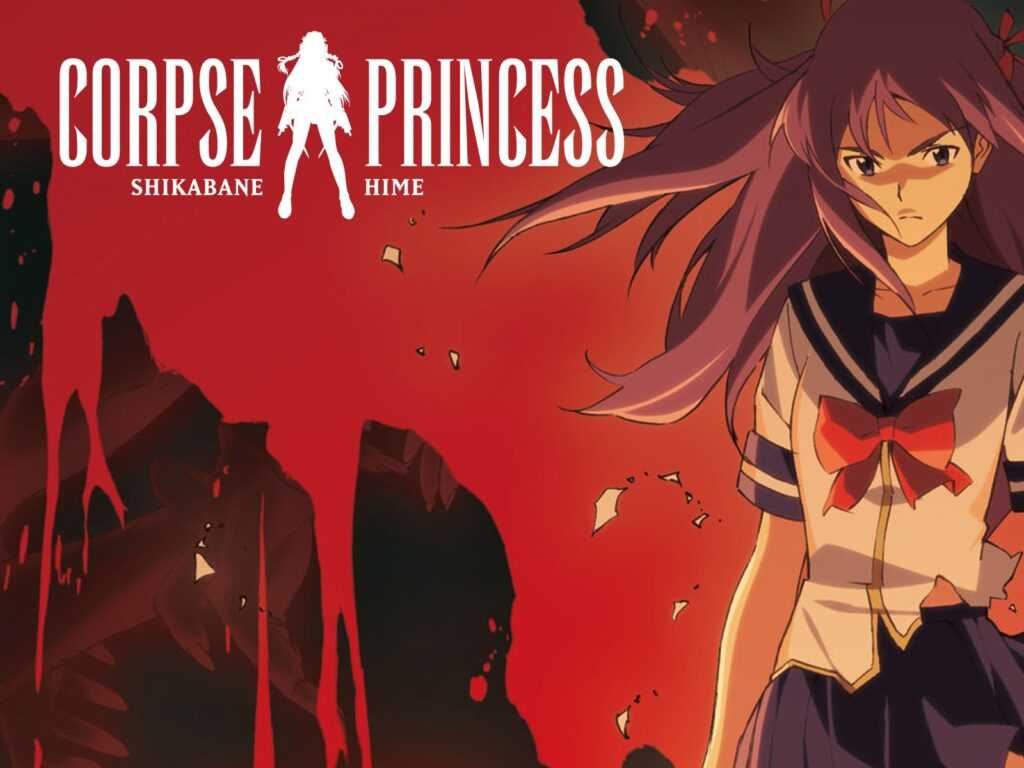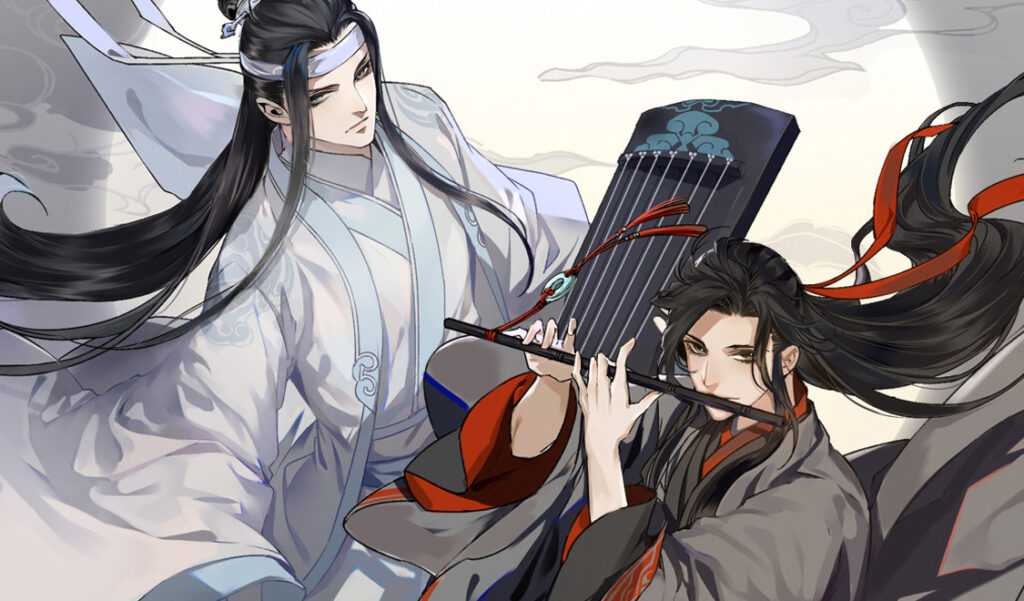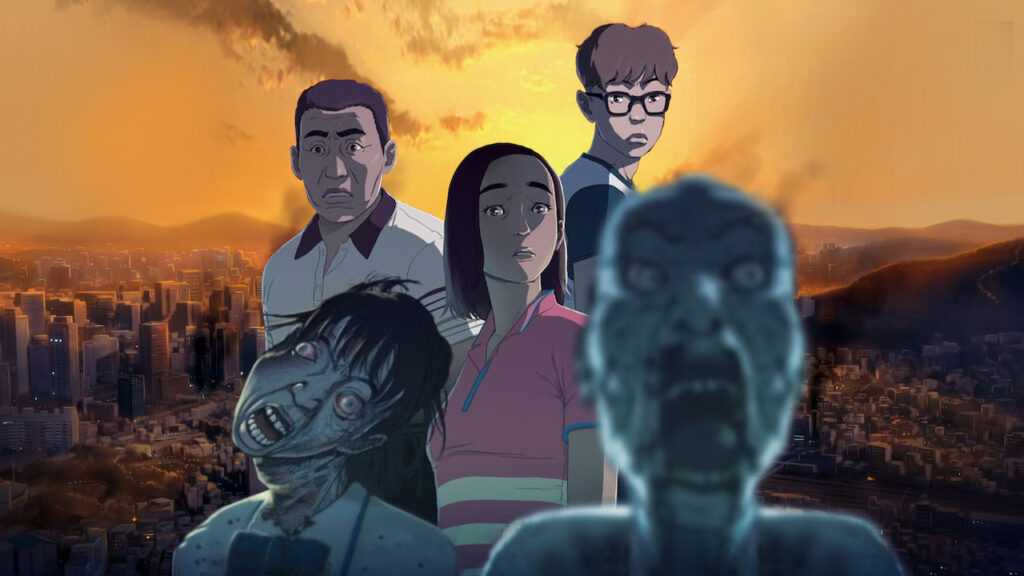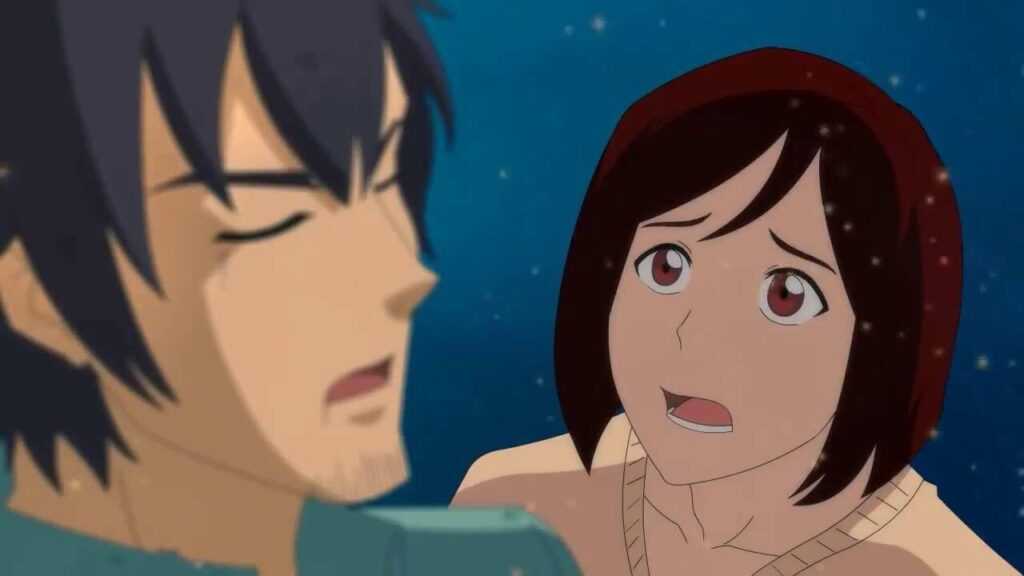Zombie-Loan (2007)

One of my absolute favorite tropes is that of a character who has some form of “True Sight”—they can see something beyond the normal world (such as death, soulmate connections, hidden supernatural creatures, etc.), and Zombie-Loan delivers on that very specific want of mine.
Michiru Kita is able to see when a person is about to die. She can see a “ring of death” on the necks of those around her—and the darker the ring, the closer one is to death. One day, she notices that two boys in her class, Chika Akatsuki and Shito Tachibana, have completely black rings. Seeking to warn them of their impending demise, she stumbles onto their secret: they are already dead but are kept alive due to a contract with Zombie-Loan, a mysterious loan office. Of course, nothing comes without a price, as the boys must hunt down and kill zombies to pay off their debt. And once they learn about Michiru’s “Shinigami Eyes,” they drag her into their crazy world.
SIGN ME UP FOR ALL OF THESE HIJINKS, PLEASE AND THANK YOU.
More important than the potential for shenanigans, however, Zombie-Loan is a story that deals with themes of life and death (duh), sacrifice, what “normal” is, and the value of human life—and then it tries to do so in eleven episodes. And then, if you’re itching to continue the story started in those eleven episodes . . . there are thirteen volumes of manga to tide you over.
Is This a Zombie?/Kore Wa Zombie Desu Ka? (2011)
Ayumu Aikawa is a 16-year-old high school student who is tragically murdered while investigating a suspicious house. However, he soon awakens next to a strange, armored girl called Eucliwood Hellscythe. She reveals herself to be a necromancer who has revived Ayumu, consequently turning him into a zombie! Now immortal, Ayumu sets out to hunt down his killer.
Aaaaaand, we’re back to bonkers-but-somehow endearing land! There are so many zombie shows that end in this category that I think it should be its own genre.
JUSTICE FOR WHOLESOME SHENANIGANS! You can pry these sorts of shows from my cold, dead hands (my zombie hands, if you would).
Despite all of the wackadoodle themes and ideas in Is This a Zombie?, this show is a very compact, comical, and enjoyable package. Normally, you might expect this type of show to be nothing but slapstick comedy, one-note gags, and little else, but instead, this anime manages to tie it all into a memorable (and, yes, humorous) story. Also, there’s a surprising amount of character depth, which is always a positive in my book. Without entertaining characters, what’s the point, am I right?
Fair warning though: this is a harem anime, so make sure this trope is your cup of tea before you dive in!
Sankarea: Undying Love (2012)
A zombie comedy! With lots of fan service.
That’s right, folks, we’ve momentarily cycled away from the gore and back into the Highschool of the Dead-esque storylines. Time to take a breather from the gore, pain, and death . . . well, not the death.
This is a list about zombies, after all.
Sankarea follows zombie-obsessed Chihiro Furuya, who has always wanted an undead girlfriend. Through a series of . . . interesting . . . events, a rich girl named Rea Sanka is accidentally turned into a “living” zombie.
Yet, despite how wacky this all seems, the core of this show has so much heart. From the animation to the music, to the fleshed (haha) out characters who have actual chemistry between them, Sankarea is definitely one to write home about. It’s a slice-of-life zombie comedy with unobtrusive bits of horror depicted in humorous ways; if you want a lighthearted jaunt that also doubles as a zombie anime, this is definitely the one you need to watch.
Tokyo Majin/Tokyo Majin Gakuen Kenpucho (2007)
Ho ho ho . . . Tokyo Majin is definitely the anime on this list with the largest adaptation pedigree: it tracks all the way back to a 1998 Nintendo role-playing video game! I’m sure there’s an anime out there that can claim similar, but I can’t think of any other zombie ones that can crow about this age/history. After watching this show, I wanted to track down the original source material and play it, but . . . alas.
Something evil is stirring in the shadows of Tokyo . . . During the spring of his senior year in high school, quiet Tatsuma Hiyuu transfers to Magami Academy in Shinjuku. He and four other students are caught in a surge of arcane energy, which awakens latent powers within them and gives them each a supernatural ability. Enlightened to their newly acquired gifts, the Magami students decide to use their power to protect the city from the onslaught of dark forces.
As you might be able to tell from the premise, this anime jumps headfirst into the shōnen anime genre. You’ve got your quiet-yet-mysterious transfer student. You’ve got his ragtag group of acquaintances-who-will-become-friends. You’ve got magic and powerups! What more could you ask for?
Tokyo Majin will have you asking questions from the first episode, but before you can bother to try and find answers for them, you’ll find yourself immediately clicking to the next episode. The animation is superb, and the design choices for the characters/enemies really emphasize the differences between our main cast and “the dark forces/undead.”
Also, those fight scenes . . . gory as hell, but so eye-catching—enough that you’ll find yourself fascinated and grossed out in equal measure. And, when it comes to zombie anime, what more can you ask for?
Tokyo Ghoul (2014)
Strap in, kids. It’s time for things to get super weird.
(Hahaha, this should come as no surprise. We’re talking about anime here, after all.)
Although this is an anime that doesn’t conform to the stereotypical idea of “zombies” that most media tend to focus on, don’t worry—if you’re looking for undead creatures that want to eat humans, you’ve come to the right place.
In Tokyo Ghoul, Tokyo has become a cruel and merciless city—a place where vicious creatures called “ghouls” exist alongside humans. The citizens of this once great metropolis live in constant fear of these bloodthirsty savages and their thirst for human flesh. However, the greatest threat these ghouls pose is their dangerous ability to masquerade as humans and blend in with society.
Definitely not a recipe for absolute disaster, am I right?
(Kidding. It’s a disaster.)
Also, similar to Highschool of the Dead (minus all the fan service/porn), Tokyo Ghoul focuses on the idea of what inescapable element or quality is it that makes someone human? If you’re half-human and half-monster . . . what are you, truly? Where do you belong if the whole world wants to kill you just for existing?
It’s a story of belonging, monsters, and existential dread . . . if you’re looking for a dark, psychological horror that blurs the line between human and monster, this is definitely one for you.
Corpse Princess (2008)

After being brutally murdered along with her family, Makina Hoshimura turns into a Shikabane Hime, a living corpse contracted to the Kougon Cult, in order to exert revenge on the mysterious undead organization responsible for her death. She is assisted in this task by Keisei Tagami, her contracted priest and former friend. This series follows the story of Keisei’s younger brother Ouri, a boy with an unusual attraction to death, who slowly discovers his brother’s secret and gets dragged into the world of the Shikabanes.
What originally drew me to this anime was the art style (well, and the zombies, of course). Also, there’s something about the phrase, “an unusual attraction to death” that really just tickles me.
Maybe I’m just an easy sell when it comes to zombie anime….nah!
But, for all that this show sounds like it might be your run-of-the-mill zombie revenge story (with the inclusion of an undead organization to boot!), its presentation is one-of-a-kind, and that’s why it’s on this list. The team behind this show does some amazing things with the plot and characters (understandable and necessary to make a good show), but also with the music (so good and apt for the tone) and the art style.
As I said originally, the art style was my original draw, and Corpse Princess doesn’t disappoint. This anime plays with colors to evoke feelings of sadness and despair, and it does so by playing primarily with a palette of grays, reds, and blacks to really emphasize and hone in on the gloomy, horrific atmosphere.
Oof, I just got chills thinking about this whole package again!
Gungrave (2003)
Based on the cult PS2 title by SEGA and Red Entertainment with the same name, Gungrave is an alternate retelling of that story. This version tells the origin story of the main character, Brandon Heat, who is later re-named Beyond the Grave, and his best friend, Harry MacDowell.
Brandon, dear readers, is our zombie in question. Also, he’s clearly not trying to hide it. Becoming a zombie and naming yourself “Beyond the Grave” is really too on the nose, don’t you think? But, despite his questionable naming practices, Brandon is such a fascinating character. In the original game this anime is based on, Brandon is a silent protagonist, and the anime does its best to stay true to that. And yet, through this show, you’re able to follow Brandon’s journey and see him go from a naïve child to a quiet, watchful man . . . and the journey with its phenomenal characterization is beautiful.
Also, there’s the mafia, science fiction elements, violence, and other entertaining elements in this show, too. Remember, we’re here for the zombies, folks!
In case you’re still not sold, Nightow Yasuhiro, the creator of Trigun, was the creator of this anime as well, and the feel of the two shows is very similar. It’s so lovely, and it feels a bit like wrapping yourself up in a Trigun-shaped blanket (for those who are fans of that show).
(Also, that soundtrack! Talk about an OST filled with absolute bangers).
The Empire of Corpses/Shisa no Teikoku (2015)
Hahahaa . . . hoo boy. Did y’all think we were out of the absolutely bonkers arena that many zombie anime like to play in?
YOU THOUGHT WRONG.
When I was originally drafting this list, I was convinced that Hellsing was going to take the cake for the sheer ludicrousness of its premise. But then . . . then, I remembered The Empire of Corpses. Perhaps I’m so utterly tickled by this movie because I’m an English Lit. nut, or maybe it’s just too wild to dislike.
Follow John Watson (yup, Sherlock Holmes’s partner) as he tries to find Viktor Frankenstein’s how-to-make-a-zombie research in order to try and breathe life back into the undead. Talk about a meeting of the minds that no one is ever prepared for . . . or something. But, as with an animated movie, there is so much going on within the animation and plot; I’d be remiss if I only discussed how weird this premise was. As one might expect in a story about undead automatons, the cast and narrative questions just what is it that makes a human. Is it the soul? Is it the ability to experience things? Is it having agency? How is it that these reanimated corpses are somehow lesser than the humans they once were? What are the ethical ramifications of working with corpses?
All in all, The Empire of Corpses has so many fun and wild elements alongside its philosophical questions: steampunk tropes, necromancy, science, flamethrowers, the Afghan War (?!?!?!), and so many other things that I refuse to spoil for you.
Sunday Without God/Kamisama no Inai Nichiyoubi (2013)
For an anime whose whole premise is about how people in this world are no longer able to die (in fact, those who do die just come back to life—yes, the citizens are, in fact, the zombies—and proceed to live life as usual), the “zombie” plot really takes a back burner to this absolute gem of a show.
Probably the show on this list with the most ambiance/personality, Sunday Without God is a thirteen-episode-long final breath.
(See what I did there? I’m hilarious).
From its absolutely stunning art style—that is so poignant it’s almost a character in its own right—to its heartwarming and heart-wrenching soundtrack, there is no other show like it on this list. This is one that will sink into your bones and stay with you long after you’ve watched the final episode.
The season that this show came out, it was such a surprise hit, and if you’ve managed to miss it after all these years, please please please do yourself a favor and immerse yourself in this world.
The Untamed/Mo Dao Zu Shi (2018)

Recently adapted into the international hit, The Untamed, Mo Dao Zu Shi is the Donghua (Chinese anime) adaptation of Mo Xiang Tong Xiu’s wildly successful novel of the same name. The action-packed story follows the adventures of Wei Wuxian and his sometimes-enemy-sometimes-friend Lan Wangji as they investigate the truth of their shared past and uncover secrets that some would prefer to stay buried.
ARE YOU LOOKING FOR A BOY’S LOVE THAT FEATURES ZOMBIES, SOULMATES, LOVE, PINING, ANGST, AND MAGIC? LOOK NO FURTHER.
This anime may only be fifteen episodes, but every minute of those fifteen episodes is a masterpiece. Everything about this show is beautiful—absolutely everything. From the music to the animation, to the characters, to the worldbuilding, to the extended universe (a novel and live-action television show as well, say what?), it is all unbelievably breathtaking.
This show was so stunning and unexpected that it dragged me down the rabbit hole of this whole universe until it was 5 AM and I was looking up fan theories of what specific Chinese terms meant in-universe and out-. (This is how we know Wei Wuxian and Lan Wangji are soulmates. There’s some fascinating discourse about it—hit me up if you’re interested.)
Also! The fandom for this show is widespread and friendly (and constantly growing), so if you’re looking for a great show and a new community, look no further! (And with Delta entering the ring with its fists swinging, we may all need to find some new communities to sink our teeth into. Fingers crossed that’s not the case, though; stay safe, everyone!)
Seoul Station/Seoul-yeok (2016)

We’re branching out, and here we have our first Korean addition to this list! Welcome, Seoul Station. You’re amongst friends.
Seoul Station is a Zombie Apocalypse movie that undoubtedly deserves to be on this list. It follows most of the tropes that are included in a typical zombie movie (survival, horror, trying to run to safety, etc. etc.), but, because said tropes are so familiar to fans of the genre, the movie can focus on other themes.
Themes of homelessness, destitution, and depictions of the Korean social lower class run rampant throughout this movie; they’re so prevalent that it’s hard to ignore them even as the characters struggle for their survival in this changed, dangerous world. Although the art style and animation might not be everyone’s cup of tea, the differing opinions said style evokes in the viewers is part of the movie’s charm.
Hellsing (2001)
Hellsing is named after and centered around the Royal Order of Protestant Knights originally led by Abraham Van Helsing. The mission of Hellsing is to search for and destroy the undead and other supernatural forces of evil that threaten the queen and the country. As the scale and frequency of incidents involving the undead escalate in England and all around the world, Sir Integra discovers that the remnants of a Nazi group called Millennium still exist and are intent on reviving Nazi Germany by creating a battalion of vampires.
. . .What a wild ride of a description! That’s how you know you’re in for a fun time.
The plot of Hellsing comes off as the bonkers love child of a historian and a supernatural enthusiast, but it is the sheer gall of putting all these elements together that, strangely enough, makes it work. As for the zombies, yup. You guessed it. Those of the Hellsing order get to do some good ol’ zombie hunting when it comes to the ghouls in this show.
(You may be noticing a theme in this list . . . that “zombies” in anime are somewhat removed from what Western audiences would normally imagine. INDEED.).
Hellsing is one of the good anime that looks at “conventions” and throws them straight out the window. Even with so much potential to flop from all these disparate elements, it works as a major success thanks to the “hip” art style, beautiful musical score, and memorable characters.
Resident Evil: Degeneration/Biohazard: Degeneration (2008)
Unless you’ve lived under a rock for the entirety of your life (which, hey, if you have, no shame. Rocks are cool.), you’ve definitely heard about Resident Evil whenever the topic of zombies comes up. Resident Evil shoehorned millions of fans into a love-love relationship with the idea of the shambling undead, and no list would be complete without this addition.
Just our luck that there was an animated movie made in 2008, isn’t it?
The plot is what you would expect from one of your standard Resident Evil works—The story is set in autumn 2005, one year after “Resident Evil 4” took place. Due to a yet-unexplained reason, zombies appear in a United States airport. The release of the zombies leads to danger of an outbreak.—and my only complaint is that, to get the full experience of this story, you should probably have some previous knowledge of the franchise.
Which. The franchise is an absolute delight. If you have the means and the time, Resident Evil is A MA ZING. Is it a perfect franchise? No. Will you care that it’s imperfect by the end? Absolutely not.
Although some viewers may question whether this majorly-CG movie should count as “anime,” I am firmly in the camp that believes that yes, it should! It’s just that good. Also, if you’re a fan of the games, much of the cast reprise their roles, so you’ll be able to hear some very familiar voices!
School-Live!/Gakkougurashi (2015)
There’s oblivious . . . and then there’s School-Live!
Yuki Takeya loves her school so much that she does not want to ever leave! Megurigaoka Private High School is a unique and lively place where Yuki enjoys her carefree life as a third-year high school student and member of the School Living Club. On top of meeting after classes, the members must live within school grounds, from sleeping over to eating meals!
“What did I just read?” you might ask.
“Did she forget we were talking about zombies?”
“Where are the zombies?”
“Surely this is a mistake.”
N.O.P.E.
I apologize for putting this on the list—as, in doing so, I’ve sort of spoiled the first episode—but if you like weird zombie shows with cute characters, you have to watch School-Live! Brace yourself, because in watching this show, you’re going to experience some extreme whiplash.
Have you ever wanted to jump straight from a cute, slice-of-life club show to a dark, post-apocalyptic horror one? Look no further! Yuki, the main character, is so oblivious to the external zombie threat that she can sometimes make you, the viewer, forget about the danger, too.
Ignorance is bliss, some might say, but in this show, ignorance is a straight-up superpower.
Yuki’s unawareness is so strong that, when the lighthearted tone needs to be dropped, all the anime has to do is cut away from her. The characters are quirky and well-defined in equal measure, and you get to learn about and love them through the significant amount of story that is told via flashbacks (how did these girls get to the school? How did the zombies appear? So on and so forth).
Although I’ve ruined it a bit for you (sorry!), make sure that, when you recommend this show to any of your friends, they go in without any preconceptions.
Ajin (2016)
IF YOU’VE NOT WATCHED THIS SHOW, DROP EVERYTHING (unless you’re holding a baby or something; please do not drop that) AND TURN IT ON RIGHT NOW.
Another “main character dies and comes back to life”-type of zombie, but with a much darker twist and themes. Ajin takes place in an alternate reality where humanity stumbled upon the discovery of a new sub-species of beings dubbed the “Ajin.” Ajin look like regular humans and are thought to be immortal, but they also have supernatural abilities.
(Of course.)
However, Ajin are super rare—to the point of being considered superstitions rather than real entities—until there’s a sudden resurgence of them in modern-day Japan. The appearance of Ajin in the plot means that the deeper themes immediately pivot to questions of “us” versus “them,” and who can truly claim the title of “human.”
If you’re looking for an anime that gets close to a 1:1 comparison with modern-day life (minus the supernatural, zombie-like entities, of course), here you go. We’ve got your xenophobia, discrimination, mob mentality, and social commentary all wrapped up in this show with a nice bow. Also, Nagai Kei, our protagonist, is so relatable—who here hasn’t been tired of the racial politics, sexual discrimination, and lack of acceptance that’s plaguing the world? We’ve all been there at some point, and seeing those feelings of disillusionment, exhaustion, and sadness in Kei is so poignant.
Also, fair warning, this is another anime with an art style that tends to divide otaku! The animation seems to be split pretty evenly between “love it” and “hate it,” but I’m sure you can tell which camp I fall into based on this review. ![]()
Kabaneri of the Iron Fortress/Koutetsujou no Kabaneri (2016)
Highly bingeable, Kabaneri of the Iron Fortress is a story that will keep you on the edge of your seat. It’s a zombie anime with a unique premise that will one-two sucker punch you from the shadows—you’ll think the plot is going to go one way, and it’ll surprise you by going against your expectations. It has a beautifully haunting and memorable soundtrack, one that fits so well with the themes of determination and struggling as the characters in this show try to survive against the Kabane (zombies). If this description hasn’t sold it for you yet, how about the fact that Kabaneri of the Iron Fortress was directed by the same person who did Death Note and Attack on Titan (which has been mentioned in our other anime listicles)?
Also! This anime takes place in a slightly more traditional setting than one would usually see in a zombie show (rural, historical Japan), but then the setting defies your expectations by mixing the traditional themes with industrial ones (did someone say trains? TRAINS!!!!).
It’s definitely one to check out!
Calamity of the Zombie Girl/Aru Zombie Shōjo no Sainan (2018)
I waffled about putting this one on the list as it’s quite polarizing (you either love it or hate it), but it seemed wrong to leave it out. Calamity of the Zombie Girl follows the story of five university students who sneak into library storage one summer day and accidentally wake up two mummified girls by stealing a mysterious stone called the “stone of life.” These girls become zombies who are determined to get the stone back, and the students must find a way to kill the girls or else they will die.
When I first saw this show, my immediate thought was, “What am I about to watch?” in tones of confusion and horror. But then, after I did my time and gasped my gasps, I asked myself, “What did I just watch?” in tones of sheer disbelief because the plot manages to work. This show knows it’s a zombie show, knows the audience it’s working with, and it stays in its lane, which adds to its appeal. It’s not trying to do anything groundbreaking and new; it’s here to be familiar to those who like zombie shows.
Having said that, you’ve got your lesbian warrior-maiden zombies who love gore, kissing, and being naked (yes, it is that type of show, so enter into it with eyes wide open) as they go on a rampage and revel in the bloodshed and violence they cause.
The production value is quite high, as expected by any work produced by Gonzo, and yet, Calamity of the Zombie continues to be an underrated and entertaining piece of media to join the ranks of other zombie anime. It’s got all the tropes one would expect from a slightly stereotypical B-List zombie horror movie—the type that scratches that very specific type of itch.
You know the one.
Gyo: Tokyo Fish Attack (2011)
If you’re even an anime fan in passing, you’ve likely heard of the famous horror manga writer, Junji Ito. Gyo: Tokyo Fish Attack is one of his works, and hoo buddy, is it a trip. This movie is another one that decides to twist the usual idea of “zombies,” and in doing so, turns this movie into a gore flick about zombie fish.
You read that right. Zombie. Fish.
Sounds sort of stupid, right? WRONG. YOU ARE VERY WRONG. (But also somewhat right, and yet it’s still so creepy). Are you laughing? Don’t. First, imagine creatures emerging from the great, dark unknown that makes up our sea, and then picture them beginning to murder people. I’ve lived near the ocean most of my life, and if whatever dwells at the bottom of the sea decided to stroll onto land one day, that would be it for all of us.
Having said that, although this is one of Junji Ito’s gems, there are quite a few . . . reprehensible/gross/disturbing/horrifying (it’s an adjective roulette!) scenes that any faint of heart viewers may want to steer really clear of.
Highschool of the Dead (2010)
It happened suddenly: the dead began to rise, and Japan was thrown into total chaos. As zombies begin terrorizing their high school, Takashi Kimuro and Rei Miyamoto escape their death trap of a school, only to be greeted by a society that has already fallen. Soon, Takashi and Rei band together with other students on a journey to find their family members and uncover what caused this overwhelming pandemic, and try to overcome the undead apocalypse.
Perhaps a controversial one to put on the list, but Highschool of the Dead is way too well-known to not end up on a zombie anime list. This is an anime that follows survivors in the wake of the Apocalypse—a Japanese take on living in a zombie world, if you would.
However, despite the quite-overdone premise (at least, when it comes to zombie media), Highschool of the Dead is quite notable for being very heartfelt. It focuses on issues about people instead of just random zombies, attacks, and killings. Unfortunately, the intended story was never finished, as the head writer died of an illness, and the artist decided not to continue the story.
Quick warning, though: there are quite a few sexual scenes/tones/moments that may not be appropriate for younger viewers.
Zombie Brother/Shi Xiong (2014)

Another back-to-the-basics zombie story! (I can hear you breathing a sigh of relief from here; there really is so much variety in the zombie genre, but sometimes, it’s nice to return to the roots!)
. . . Sort of.
Protagonist Xiao Fei used to be an ordinary guy from H city. After the spring water was contaminated with a virus, however, he unexpectedly encountered an unprecedented crisis. The people living in H City became zombies one by one, devouring each other, and gradually evolving. Can Xiao Fei escape from H city and meet up with his girlfriend, Wei?
Whenever a premise starts out with, “X used to be normal,” you know you’re in for a good time. Although subject to much debate and controversy (thanks, Chinese censorship laws), Zombie Brother has been a very powerful and influential work when it comes to young adult animation in China.
Despite the gravity of the premise, this series is a humorous parody that teases and prods at many ideas and elements intrinsic to both modern Chinese society and the widespread workings of the wider world. And yet, it wouldn’t have made this list if it didn’t do something fun and new with those zombies y’all are here for!
Zombie Brothers sort of sidesteps the largest and most obvious zombie tropes by making the antagonist the main zombie player. He never seems to die, even as the protagonist tries his best to save everyone and survive to see another day, but then, he also has a strange obsession with . . . paper currency??? This anime is like an onion—you have to peel through the layers to get to the core of it and truly understand what this show is trying to depict—but some of those layers are there to really throw you for a loop.
Fair warning for younger audiences . . . some of the author’s jokes are so scandalous/inappropriate that they’ve been deleted from the online manga. Yeowch.







![[top 10] best zombie anime of all time | gamers decide](http://mpshes.ru/wp-content/uploads/4/d/c/4dc0ec3ae5a6535021c3074867ef32de.jpeg)
![Предсмертный список зомби / zom 100: zombie ni naru made ni shitai 100 no koto [1-7 из 12+] [8 серия - 10 сентября] » база №1 по просмотру аниме онлайн бесплатно](http://mpshes.ru/wp-content/uploads/e/b/0/eb01c4d938597f7793b71f3a4a5f0720.jpeg)






![Top 25 best zombie anime in [2023]](http://mpshes.ru/wp-content/uploads/c/b/f/cbf716758e315ab468e79c0d96ba21fd.jpeg)










![Предсмертный список зомби / zom 100: zombie ni naru made ni shitai 100 no koto [1-7 из 12+] [8 серия - 10 сентября]](http://mpshes.ru/wp-content/uploads/4/5/3/45313b08453c5ac43f6259bc39cbea28.png)